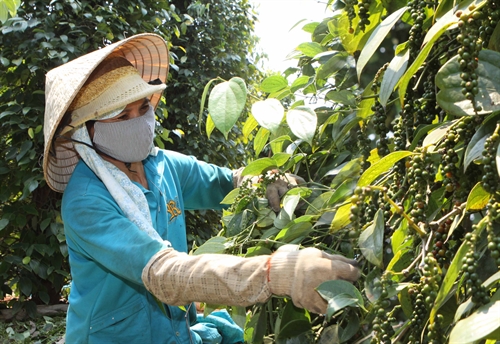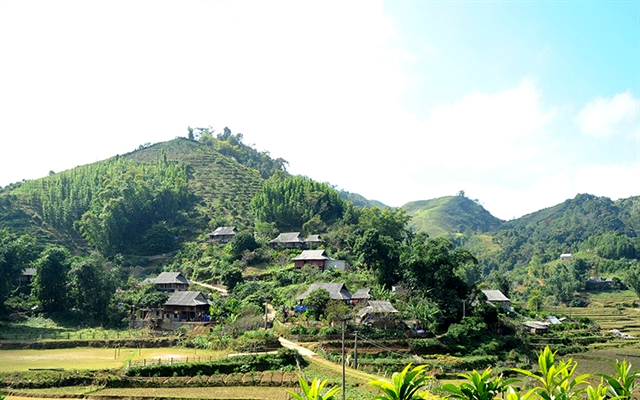 Economy
Economy

The high price of pepper, combined with a drop in coffee prices, has caused many farmers to switch to cultivating pepper vines.
 |
| A farmer harvests pepper in Cư Kuin District of Đắk Lắk Province. Many farmers in the Central Highlands region have switched to pepper crops recently. - VNA/VNS Photo Dương Giang |
HCM CITY – The high price of pepper, combined with a drop in coffee prices, has caused many farmers to switch to cultivating pepper vines.
Experts have warned, however, that unzoned pepper development could hurt farmers in the long term.
In Đắk Lắk Province, considered the country’s coffee capital, many farmers are now growing pepper.
Hoàng Minh Hùng cut down 1ha of coffee trees to grow pepper in Đắk Lắk’s Krông Năng District in March.
“Many families here have switched to pepper,” he said.
Đắk Lắk has the largest pepper cultivating area in the Central Highlands region, according to the provincial People’s Committee.
As of May, Đắk Lắk had nearly 22,000ha of pepper, exceeding 15,000ha compared to the province’s zoned pepper cultivation area for 2015.
Similarly, the Central Highlands province of Gia Lai plans to have 6,000ha of pepper in 2020 but the province’s current pepper area is more than 12,000ha.
Đỗ Hà Nam, chairman of the Việt Nam Pepper Association, said the country’s pepper area had reached about 100,000ha as of the end of March, double the country’s pepper area zoned to 2020 by the Ministry of Agriculture and Rural Development.
The pepper areas in Southeast and Tây Nguyên (Central Highlands) provinces would continue to increase by 10 – 20 per cent in the coming time, he said.
"If agencies do not have measures to limit unzoned pepper development, the pepper sector’s sustainable development will be affected," he said.
Currently, pepper farmers grow the plant on many kinds of soil, including in areas not suitable for pepper cultivation.
Many farmers have also intercropped pepper in rubber orchards, which can cause rubber trees infected with phytopthora, a kind of fungi, to die, according to experts.
A number of farmers overuse fertiliser and pesticides to increase yield, causing a decline of pepper quality.
Trần Vinh, deputy head of the Central Highlands Agriculture and Forestry Science Institute, said pepper seedlings without clear origin were being used due to the lack of information about disease-prevention techniques, as well as farmers chasing after profits.
This could lead to the mass death of pepper plants caused by disease outbreaks or pepper bearing no fruit, he said.
Farmers could suffer severe losses, he said.
To grow 1ha of pepper, farmers have to invest more than VNĐ500 million (US$22,000).
Pepper companies are now buying pepper from farmers at a price of VNĐ170,000-180,000 ($7.7 – 8.1) a kilo.
The price of pepper has been high for nearly 10 years, providing stable profits for farmers.
Việt Nam is the world’s top pepper exporter. The country exported about 70,000 tonnes of pepper worth $562 million in the first four months of the year, up nearly 24 per cent in volume and 10 per cent in value against the same period last year, according to the Việt Nam Pepper Association.
Drought damage
Drought has affected more than 120,000ha of coffee and pepper in the Central Highlands region, the Ministry of Agriculture and Rural Development’s Plant Cultivation Department said at a forum held in Gia Lai Province on Thursday.
Of the figure, 496ha of pepper and 6,500ha of coffee have been destroyed.
Most of the destroyed areas were in unzoned areas, said the Plant Cultivation Department.
Of the region’s affected provinces, Đắk Lắk has been the hardest-hit province with more than 60,000ha of affected coffee and pepper.
In areas which not suited for growing coffee and pepper, farmers should switch to other suitable trees and crops, said experts at the forum.
They also instructed farmers in methods to recover coffee and pepper orchards after drought.
Farmers were urged to use advanced farming techniques, including drip irrigation and spray irrigation techniques.
Coffee and pepper are the two major farm crops in the Central Highlands region. – VNS

.jpeg)


